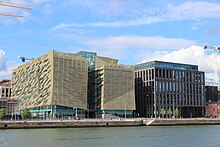Central Bank of Ireland
| Headquarters | Dublin , Ireland |
| founding | February 1, 1943 |
| president | Gabriel Makhlouf |
| country | Ireland |
| currency | |
| ISO 4217 | EUR |
| Website | |
| List of central banks | |
The Central Bank of Ireland ( Irish Banc Ceannais na hÉireann ; German Central Bank of Ireland ) is Ireland's central bank and financial regulator . It is part of the European System of Central Banks (ESCB) and the authority that mints Irish euro coins - in the Currency Center in Sandyford .
The bank has been headquartered on North Wall Quay in Dublin on the banks of the Liffey since 2017 ; previously it was located on Dublin's Dame Street near Temple Bar and Trinity College from 1979 to 2017 .
history
The Central Bank of Ireland (the “Bank”) was established by the Central Bank Act 1942. It replaced the former Currency Commission established by the Currency Act 1927. The bank was created as a corporation with an official seal. She was granted legal capacity under Section 5 of the Central Bank Act 1942.
Section 7 of the Central Bank Act 1942 sets out the rights and powers of the bank, including the power to buy (sell) coins, foreign currency, gold and silver bars. The Bank has been authorized to accept deposits from the Minister, any public authority or any credit institution operating in whole or in part in the Irish State. In addition, the bank was empowered to buy or sell government securities and to make loans or advance payments to commercial banks.
The Bretton Woods Agreements Act 1957 gave the bank the power to participate in the Bretton Woods system . Additional rights relating to the financial management of the country have been acquired by the Treasury Department through the International Financial Corporation Act 1958, the International Financial Development Act 1960 and the Bretton Woods Agreements (Amendment) Acts 1969–1999.
The role of the Bank has expanded in proportion to the growing size of Irish financial markets and the development of global finance. The Central Bank Acts 1971, 1989 and 1997 essentially expanded the role and powers of the bank. The Central Bank Act 1971 gave the Bank additional powers to license and oversee credit institutions operating in Ireland . The Central Bank Act 1997 established the role of the bank as the regulator of the payment method. The Central Bank Act 1989 repealed the Currency Act 1927 and introduced significant changes to the powers and duties of the Central Bank. These included:
- strengthening the bank's licensing and regulatory rights;
- the licensing and administration of a program to protect retail investors at credit institutions;
- the supervision of certain financial institutions in the Dublin International Financial Services Center;
- the change in the structure of the bank's board of directors.
Over time, the bank's supervisory role has expanded and additional obligations relating to the supervision of finance companies have been established in the Building Societies Act, 1989, the Trustee Savings Bank Act 1989, the Unit Trusts Act 1990, and the Companies Act 1990. Today the bank is considered Ireland's primary licensing and regulatory agency.
Ireland's entry into the Economic and Monetary Union (EMU) deprived the bank of its monetary function. Through the Central Bank Act 1998, Ireland's monetary policy was determined by the ECB. Clause 4 of the 1998 Act supplements Clause 5 of the 1942 Act and stipulates that the bank has to carry out all obligations and functions arising from the Treaty of Rome 1957 or from the laws and decisions of the European System of Central Banks (ESCB) and the European Central Bank emerge.
The bank was restructured on May 1, 2003 and renamed the Central Bank and Financial Services Authority of Ireland (CBFSAI). This authority performs all of the functions of the old Central Bank of Ireland; In addition, she got new supervisory and consumer protection functions for consumers in the financial services sector. The two main branches of the CBFSAI are:
- the Central Bank, responsible for the execution of the monetary policy determined by the ECB, stability of the financial markets, economic analysis, currency and payment method and the management and investment of foreign and domestic currencies and securities;
- the Irish Financial Services Regulatory Authority (Financial Regulator), an independent body within the CBFSAI responsible for overseeing the financial sector and protecting its consumers.
Directors of the Central Bank of Ireland
The Director (Irish: An Gobharnóir) of the Bank is appointed by the Irish President in consultation with the Irish Government.
- Joseph Brennan
- JJ McElligótt
- M. Muimhneacháin
- TK Whitaker
- CH Murray
- Tomás F. Ó Cofaigh
- M. Doyle
- Muiris S. Ó Conaill
- John Hurley
- Patrick Honohan
- Philip R. Lane
- Gabriel Makhlouf (current)
Web links
- Official website (English).
